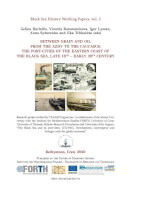NEW PUBLICATION! Gelina Harlaftis, Victoria Konstantinova, Igor Lyman, Anna Sydorenko and Eka Tchkoidze (eds), Between grain and oil from the Azov to the Caucasus: the port-cities of the eastern coast of the Black Sea, late 18th – early 20th century

NEW PUBLICATION! Gelina Harlaftis, Victoria Konstantinova, Igor Lyman, Anna Sydorenko and Eka Tchkoidze (eds), Between grain and oil from the Azov to the Caucasus: the port-cities of the eastern coast of the Black Sea, late 18th – early 20th century, Black Sea History Working Papers, volume 3, Rethymnon, 2020
The fifth book of the Black Sea Working Papers series deals with seven main port-cities that grew along its coast, that became the main gateways to the West serving probably the largest hinterland of any port-cities in Europe: Kerch, Berdyansk, Mariupol, Taganrog, Rostov-on-Don, Novorossiysk and Batoum. Contrary to nation-centred analyses, this book follows a maritime history approach, beyond political boundaries; a history of transport and communication. The aim is to indicate the dynamic changes of the port cities that came from the formation of land and sea transport systems. It will further indicate the ways the area was integrated to the global economy. By the beginning of the 20th century the eastern coast of the Black Sea was among the main grain and oil producing areas of the world. This was an incredible achievement of a combination of river, land and sea port transport system that served a vast and sparsely populated hinterland that connected it to the global markets. The area includes the 'inner sea', the Azov Sea, the most known mountain of the Black Sea, the proud and insubordinate Caucasus, a vast hinterland that includes an incredible river network of Europe's largest rivers like the Volga and Don, endless steppes of grain fields grown on the fertile black earth, amazing coal - and mineral fields in the Donetz basin and amazing quantities of the black gold, petroleum, on the shores of the Caspian Sea that found its way to the world through Batoum. From 1860s to 1913 Russia had become the world’s largest grain producer and world's largest producer of petroleum.




